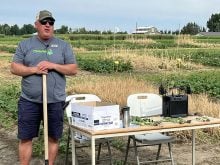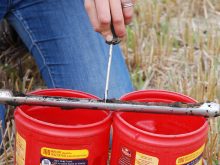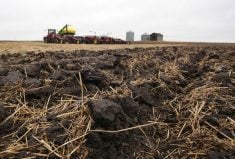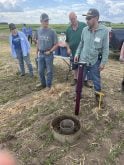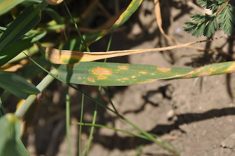Any farmer who practises zero tillage could have soils that are acidic, says a crop specialist from North Dakota State University.
That includes farmers in Western Canada.
The entire soil profile won’t be acidic and it may only be a problem on parts of a field, but no-tillers could have a band of soil, or a stratified layer, with a pH of 5.5 or lower.
“Anywhere there is reduced tillage, there’s going to be spots that will have this (low pH),” said Ryan Buetow, a cropping systems specialist with NDSU in Dickinson, N.D.
Read Also

Geopolitics can change trade routes
WHISTLER, B.C. — Today’s geopolitical tensions could have dire long-term consequences, says the director of international policy at the University…
“It might not be every acre (on a farm). But even if it’s 30 percent, that’s a lot of acres.”
Buetow shared his experience and knowledge of acidic soils at the Manitoba Agronomists’ Conference, held mid-December at the University of Manitoba. As part of the presentation, he showed a map of where acidic soils have been detected in the state. Many of the locations are in the western and southwestern parts of North Dakota. But acidic soils have been found right up to the Canadian border and on the eastern side of the state.
“I’ve seen (pH) as low as 3.9 in western North Dakota,” he said, adding there are many fields with pH of five or less in the state. “This is a major issue in Montana and Idaho. I know there are some guys in Saskatchewan that have this issue. Anywhere there’s been no till…. (there is) stratified soil acidity.”
Buetow explained that acidity and where it happens in the soil largely depends on what type of fertilizer is applied and how it’s applied. But zero tillage is a factor.
“What we’re really talking about here today, is acidity formed by nitrogen fertilizer. In a reduced tillage system, especially, you’re applying nitrogen in a very consistent spot (layer of soil) year after year,” he said. “Say we’re doing no till for 10 or 20 years. Every year, a little bit more of that (nitrogen) is being put down…. All of a sudden you have this band of acidity, at two or three inches down in the soil.”
If it’s broadcasted urea, low pH can be a problem in the top few centimetres of the soil.
“If it’s anhydrous ammonia or nitrogen put in mid-row band, side by side, you’re going to see that acidity a little deeper down,” Buetow said, possibly at a depth of six to seven cm.
Acidic soils have become a widespread problem in North Dakota, so NDSU experts created a webpage and document to educate growers. The webpage at bit.ly/3jFHvUa explains that aluminum becomes soluble when the soil pH is too acidic. A pH of six is considered to be moderately acidic. A pH of 5.5 or lower is strongly acidic.
“High levels of (aluminum) in the soil solution affect plant root development and growth…. This results in a poor plant rooting system that interferes with its uptake, transport and use of nutrients… as well as water,” the webpage says. “In addition, (aluminum) bonds with P (phosphorus) to form less available P, causing P deficiency symptoms. Therefore, plants exposed to toxic aluminum levels show poor growth, water stress and nutrient deficiencies.”
Legume crops are particularly sensitive to low pH because soil bacteria function poorly in acidic soils, thus reducing nitrogen fixation.
In canola, plant damage from acidic soils can look a lot like clubroot, a soil-borne disease.
“You get these stunted roots… (and) reduced growth,” Buetow said.
John Heard, soil fertility speciality with Manitoba Agriculture, said the symptoms in canola are similar to herbicide damage.
“We do see this occurring in some canola (fields). Canola acidic soil looks just like Group 2 injury.”
Many producers in North Dakota may have acidic soils, but some are unaware and others are reluctant to act, Buetow said.
Adding lime to the soil will push the pH higher, but some producers in North Dakota aren’t willing to take that step.
“It’s a mixture of cost and it’s something they (farmers) haven’t had to do,” Buetow said.
The cost can be significant because a substantial amount of lime is needed to neutralize the soil.
“Lime works. But a low rate of lime, anything below 400 pounds (per acre), isn’t worth it.”
A few North Dakota farmers have experimented with low rates of lime in furrow.
“That doesn’t seem to do anything.”
Farmers who rent acres are often hesitant to apply lime. Why spend tens of thousands of dollars to fix a problem for the person who owns the land?
“Some guys don’t want to put the investment in,” Buetow said.
Tillage can help but it’s not going to solve the problem.
“Short term, you’ll lose the great benefits of no till. It doesn’t always fix it,” he said. “Anything other than lime is a short-term Band-Aid.”
Following his presentation at the Manitoba Agronomists’ Conference, Buetow said that acidic soils and how to manage them have become a major part of his job.
He frequently gets calls from North Dakota producers asking for information or help with low pH soils.
Fortunately, he’s not working alone. He’s collaborating with a group of producers who are aware of the problem and have taken action to raise their soil pH.
They’re spreading the word to their fellow farmers.
“A lot of guys don’t really look at pH … (but) if you’re seeing a weird spot out there (in the crop), I would start (by) paying more attention to pH,” Buetow said.
“(It) should be part of your troubleshooting, especially if you’re working in zero till.”




